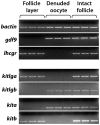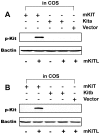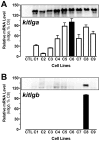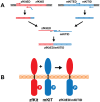Spatial distribution and receptor specificity of zebrafish Kit system--evidence for a Kit-mediated bi-directional communication system in the preovulatory ovarian follicle
- PMID: 23409152
- PMCID: PMC3568072
- DOI: 10.1371/journal.pone.0056192
Spatial distribution and receptor specificity of zebrafish Kit system--evidence for a Kit-mediated bi-directional communication system in the preovulatory ovarian follicle
Abstract
Consisting of Kit ligand and receptor Kit, the Kit system is involved in regulating many ovarian functions such as follicle activation, granulosa cell proliferation, and oocyte growth and maturation. In mammals, Kit ligand is derived from the granulosa cells and Kit receptor is expressed in the oocyte and theca cells. In the zebrafish, the Kit system contains two ligands (Kitlga and Kitlgb) and two receptors (Kita and Kitb). Interestingly, Kitlga and Kitb are localized in the somatic follicle cells, but Kitlgb and Kita are expressed in the oocyte. Using recombinant zebrafish Kitlga and Kitlgb, we demonstrated that Kitlga preferentially activated Kita whereas Kitlgb specifically activated Kitb by Western analysis for receptor phosphorylation. In support of this, Kitlgb triggered a stronger and longer MAPK phosphorylation in follicle cells than Kitlga, whereas Kitlga but not Kitlgb activated MAPK in the denuded oocytes, in agreement with the distribution of Kita and Kitb in the follicle and their specificity for Kitlga and Kitlgb. Further analysis of the interaction between Kit ligands and receptors by homology modeling showed that Kitlga-Kita and Kitlgb-Kitb both have more stable electrostatic interaction than Kitlgb-Kita or Kitlga-Kitb. A functional study of Kit involvement in final oocyte maturation showed that Kitlga and Kitlgb both suppressed the spontaneous maturation significantly; in contrast, Kitlgb but not Kitlga significantly promoted 17α, 20β-dihydroxy-4-pregnen-3-one (DHP) -induced oocyte maturation. Our results provided strong evidence for a Kit-mediated bi-directional communication system in the zebrafish ovarian follicle, which could be part of the complex interplay between the oocyte and the follicle cells in the development of follicles.
Conflict of interest statement
Figures














Similar articles
-
Differential regulation of Kit ligand A expression in the ovary by IGF-I via different pathways.Mol Endocrinol. 2014 Jan;28(1):138-50. doi: 10.1210/me.2013-1186. Epub 2013 Nov 21. Mol Endocrinol. 2014. PMID: 24243489 Free PMC article.
-
Kit system in the zebrafish ovary: evidence for functional divergence of two isoforms of kit (kita and kitb) and kit ligand (kitlga and kitlgb) during folliculogenesis.Biol Reprod. 2010 Jun;82(6):1216-26. doi: 10.1095/biolreprod.109.082644. Epub 2010 Mar 3. Biol Reprod. 2010. PMID: 20200213
-
Differential regulation of kit ligand A (kitlga) expression in the zebrafish ovarian follicle cells--evidence for the existence of a cyclic adenosine 3', 5' monophosphate-mediated binary regulatory system during folliculogenesis.Mol Cell Endocrinol. 2015 Feb 15;402:21-31. doi: 10.1016/j.mce.2014.12.005. Epub 2014 Dec 23. Mol Cell Endocrinol. 2015. PMID: 25542847
-
Stem cell factor (SCF)-kit mediated phosphatidylinositol 3 (PI3) kinase signaling during mammalian oocyte growth and early follicular development.Front Biosci. 2006 Jan 1;11:126-35. doi: 10.2741/1785. Front Biosci. 2006. PMID: 16146719 Review.
-
Control of mammalian oocyte growth and early follicular development by the oocyte PI3 kinase pathway: new roles for an old timer.Dev Biol. 2006 Nov 1;299(1):1-11. doi: 10.1016/j.ydbio.2006.07.038. Epub 2006 Aug 5. Dev Biol. 2006. PMID: 16970938 Review.
Cited by
-
Differential regulation of Kit ligand A expression in the ovary by IGF-I via different pathways.Mol Endocrinol. 2014 Jan;28(1):138-50. doi: 10.1210/me.2013-1186. Epub 2013 Nov 21. Mol Endocrinol. 2014. PMID: 24243489 Free PMC article.
-
The Expression Pattern of Insulin-Like Growth Factor Subtype 3 (igf3) in the Orange-Spotted Grouper Epinephelus coioides and Its Function on Ovary Maturation.Int J Mol Sci. 2023 Feb 2;24(3):2868. doi: 10.3390/ijms24032868. Int J Mol Sci. 2023. PMID: 36769198 Free PMC article.
-
c-Kit Receptor Maintains Sensory Axon Innervation of the Skin through Src Family Kinases.J Neurosci. 2022 Sep 7;42(36):6835-6847. doi: 10.1523/JNEUROSCI.0618-22.2022. J Neurosci. 2022. PMID: 35882558 Free PMC article.
-
Transcriptomic Analysis for Differentially Expressed Genes in Ovarian Follicle Activation in the Zebrafish.Front Endocrinol (Lausanne). 2018 Oct 11;9:593. doi: 10.3389/fendo.2018.00593. eCollection 2018. Front Endocrinol (Lausanne). 2018. PMID: 30364302 Free PMC article.
References
-
- Copeland NG, Gilbert DJ, Cho BC, Donovan PJ, Jenkins NA, et al. (1990) Mast cell growth factor maps near the steel locus on mouse chromosome 10 and is deleted in a number of steel alleles. Cell 63: 175–183. - PubMed
-
- Huang E, Nocka K, Beier DR, Chu TY, Buck J, et al. (1990) The hematopoietic growth factor KL is encoded by the Sl locus and is the ligand of the c-kit receptor, the gene product of the W locus. Cell 63: 225–233. - PubMed
-
- Matsui Y, Zsebo KM, Hogan BL (1990) Embryonic expression of a haematopoietic growth factor encoded by the Sl locus and the ligand for c-kit. Nature 347: 667–669. - PubMed
-
- Chabot B, Stephenson DA, Chapman VM, Besmer P, Bernstein A (1988) The proto-oncogene c-kit encoding a transmembrane tyrosine kinase receptor maps to the mouse W locus. Nature 335: 88–89. - PubMed
Publication types
MeSH terms
Substances
LinkOut - more resources
Full Text Sources
Other Literature Sources
Molecular Biology Databases

